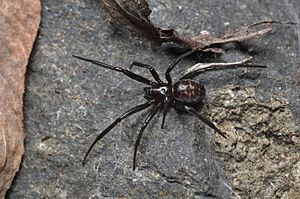Steatoda capensis facts for kids
Quick facts for kids Steatoda capensis |
|
|---|---|
 |
|
| Female | |
| Scientific classification | |
| Synonyms | |
|
Teutana lepida |
The Steatoda capensis is a small spider that originally comes from South Africa. People call it by many names, like the black cobweb spider, brown house spider, or cupboard spider. In New Zealand, it's often called the false katipō because it looks a bit like the native katipō spider.
This spider is very common in Southern Africa. It has also traveled to other countries and can now be found in Australia and all over New Zealand. It's usually a shiny black color. Sometimes, it might have a small bright red, orange, or yellow spot near the end of its body. It can also have a crescent-shaped band closer to its head.
If a Steatoda capensis spider bites a human, it can cause some pain and make you feel a bit unwell for about a day. This is known as "steatodism," which is like a milder version of what a Redback spider bite might cause.
Contents
What's in a Name?
The name "capensis" comes from Cape Town, a city in South Africa. This is where the spider was first discovered.
Spider Family Tree
The Steatoda capensis spider has had a few name changes over the years! It was first described in 1904 by Octavius Pickard-Cambridge. He called it Teutana lepida. Later, scientists realized it belonged to a different group of spiders called Steatoda. So, in 1977, its name changed to Steatoda lepida. But then, they found out there was already another spider with that exact name! So, in 1990, they finally gave it the name Steatoda capensis to avoid confusion.
Where Do These Spiders Live?
The Steatoda capensis spider is originally from South Africa. However, it has spread to other places like Australia and is very common in New Zealand.
These spiders often live near people, inside or on buildings. They are known as "synanthropic" animals, meaning they like to live close to humans. You can also find them in other places, like sand dunes.
Spider Life in Nature
In New Zealand, Steatoda capensis spiders live in sand dunes, which is also where the native katipō spider lives. Both spiders like similar living spaces and food. However, Steatoda capensis spiders can have babies much faster than katipō spiders. Because of this, scientists think that Steatoda capensis might be taking over the homes of katipō spiders. This could be one reason why the number of katipō spiders is going down.
What Happens if a Spider Bites?
While not dangerous, Steatoda capensis spiders can give a painful bite if they feel threatened. Most bites come from female spiders, but males can also bite.
A bite from a Steatoda capensis spider can cause some discomfort. This is sometimes called "steatodism," which is a milder version of what a bite from a Redback spider might cause. Usually, the bite area will hurt and turn red. Some people might also feel sick to their stomach or get a headache. If someone is bitten, the antivenom used for Redback spider bites might also help with Steatoda capensis bites.
Images for kids
See also
 Learn more in Spanish: Steatoda capensis para niños
Learn more in Spanish: Steatoda capensis para niños


